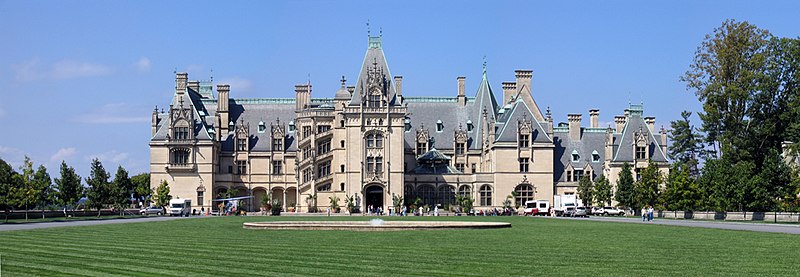George Washington Vanderbilt II
George Washington Vanderbilt II | |
|---|---|
Richmond County, New York, New York, U.S. | |
| Died | March 6, 1914 (aged 51) Washington, D.C., U.S. |
| Resting place | Vanderbilt Family Mausoleum, Staten Island, New York, U.S. |
| Known for | Biltmore Estate |
| Spouse |
Edith Stuyvesant Dresser (m. 1898) |
| Children | Cornelia Stuyvesant Vanderbilt |
| Parent(s) | William Henry Vanderbilt Maria Louisa Kissam |
| Relatives | Vanderbilt family |
George Washington Vanderbilt II (November 14, 1862 – March 6, 1914) was an American art collector and member of the prominent
Biography

George W. Vanderbilt II was the youngest child of William Henry Vanderbilt and Maria Louisa Kissam. Though there is no evidence to suggest that he referred to himself using a numerical suffix, various sources have called him both George Washington Vanderbilt II and III. Biltmore recognizes him as George W. Vanderbilt III, because he had two uncles by that name, the first of whom died at the age of four.[2]
As the youngest of William's children, George was said to be his father's favorite and his constant companion. Relatives described him as slender, dark-haired, and pale-complexioned. Shy and introverted, his interests ran to philosophy, books, and the collection of paintings in his father's large art gallery. He acquired a private library of more than twenty thousand volumes. In addition to frequent visits to Paris, France, where several Vanderbilts kept homes, George Vanderbilt traveled extensively and became fluent in several languages.[3]
His father owned elegant mansions in New York City and
He ran the family farm at New Dorp and Woodland Beach, now the neighborhood of Midland Beach, on Staten Island, New York, where he was born, then lived with his mother in Manhattan until his own townhouse at 9 West 53rd Street was completed in 1887. The Vanderbilt family business was operated by his elder brothers. This left him time for intellectual pursuits. In 1891, he joined the New York Society of the Sons of the American Revolution. The next year Vanderbilt gifted his private gallery on 58th Street in Manhattan to the American Fine Arts Society.[4] During the early 1900s, the Vanderbilts developed a pair of residences at 645 and 647 Fifth Avenue. George was the first owner of number 647.[5]
Biltmore
Living in one or another of his family residences well into adulthood, Vanderbilt decided to construct his own country mansion and estate in 1888. For this purpose, he acquired 125,000 acres of woodland in North Carolina, employing the architect
At Biltmore, Vanderbilt led the life of a country gentleman. Having a great interest in
Vanderbilt was known for his generosity toward his employees at Biltmore. Every year, he held a Christmas celebration for their children, complete with decorated tree and presents for each child, even those who could not make it to the party. He also paid all the expenses of the Cathedral of All Souls, an Episcopal cathedral he'd built and was a parishioner of, located directly across from the Biltmore Estate's main gate in Biltmore Village (the model village he had built for those who had worked to build the Estate or were employed on the Estate), so that the church's weekly collection could go directly to charity and outreach.[7]

Family
On June 1, 1898, Vanderbilt married
In 1912, George and Edith booked passage on the doomed
Death
Vanderbilt died of complications following an
Legacy
After his death, Vanderbilt's widow sold approximately 86,000 acres (350 km2) of the Biltmore property to the
The Vanderbilts' only child,
References
- ^ New York Times. March 7, 1914. Retrieved April 21, 2011.
George Washington Vanderbilt of New York died suddenly this afternoon at his Washington residence, 1,612 K Street. With him at the time were Mrs. Vanderbilt and their thirteen-year-old daughter, Miss Cornelia S. Vanderbilt.
- ^ Klingner, Leslie (May 1, 2011). "George Vanderbilt". Biltmore. Retrieved April 7, 2017.
- ISBN 978-0-385-60827-5.
- ISSN 0362-4331. Retrieved December 4, 2020.
- ^ "George W. Vanderbilt Residence" (PDF). New York City Landmarks Preservation Commission. March 22, 1977. Retrieved June 20, 2021.
- ISBN 978-0-385-60827-5.
- New York Times. March 7, 1914. Retrieved November 2, 2017.
- ^ Eaton, John P. (April 6, 2008). "Cancelled Passages Aboard Titanic". Encyclopedia Titanica. Retrieved December 15, 2020.
- ISBN 9781476794068.
- ISBN 9780393315134.)
{{cite book}}: CS1 maint: multiple names: authors list (link
Further reading
- Vanderbilt, Arthur T. II. (1989) Fortune's Children: The Fall of the House of Vanderbilt New York: Quill / William Morrow. ISBN 0-688-10386-3. p. 40 (the death of G. W. Vanderbilt 1), pp. 55–83 (William H. Vanderbilt), pp. 271–279 (George W. Vanderbilt III).
- Curiosity served: Biltmore opens servants' quarters at The San Diego Union-Tribune December 25, 2005
